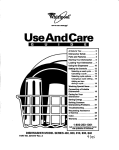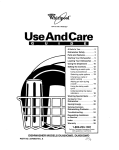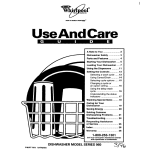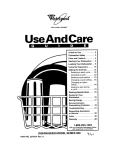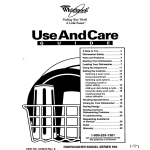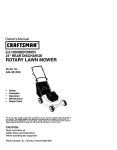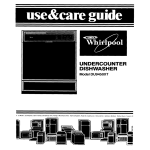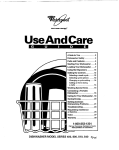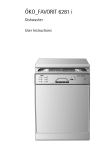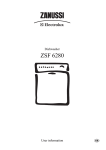Download Roper UNDERCOUNTER DISHWASHERS Specifications
Transcript
ROPER” HomeAppliancer UseAndCare A Note to You ......................... 2 Dishwasher Safety ................. 3 ................. 4 Parts and Features Starting Your Dishwasher ............................. 6 Loading Your Dishwasher ............................. 7 Using the Dispensers .......... 10 Setting the Controls ............. 12 Selecting a wash cycle ..... 12 Selecting cycle options ... .I3 Changing a cycle setting.. .14 Adding an item during a cycle .............................. 14 Washing Items ........ 15 Special Caring for Your Dishwasher ........................... Saving Energy ...................... Solving Common Dishwashing Problems.. Troubleshooting 16 18 ...... 19 ................... 22 Requesting Assistance or Service .............................. 23 Index.. .................................... 27 ............................... 28 Warranty I-800-44-ROPER Call us with questions UNDERCOUNTER PART NO. 3376809 or comments. DISHWASHERS 5 A Note to You Thank you for buying a Roper” appliance. Roper appliances give you all the functionality of name brand appliances at a value price. To ensure you enjoy years of trouble-free operation, we developed this Use and Care Guide. It contains valuable information about how to operate and maintain your appliance properly and safely. Please read it carefully. Also, please complete and mail the Ownership Registration Card provided with your appliance. This card helps us notify you about any new information on your appliance. Please record your model’s information. Whenever you call to request service for your appliance, you need to know your complete model number and serial number. You can find this information on the model and serial number label (see diagram on page 4 for location of label). Please also record the purchase date of your appliance and your dealer’s name, address, and telephone number. Keep this book and the sales slip together Help us help See Installation information. Instructions Date Dealer Name Dealer Address Dealer Phone in a safe place for future reference. l l l l Remove all shipping plugs from hoses and connectors (such as the cap on the drain outlet) before installing.* Remove all hang tags and temporary labels. Make sure dishwasher is not used by anyone unable to operate it properly. Properly maintain dishwasher. See page 16. for complete Our toll-free number is available 24 hours a day. 2 Purchase you Please: l Have your dishwasher installed by a qualified installer. l Install where dishwasher is protected from the elements. l Install and level dishwasher on a floor that will hold the weight, and in an area suitable for its size and use. l Properly connect dishwasher to electricity, water, and drain.* l Model Number Serial Number I-800-447-6737 / Dishwasher Your safety is important Safety to us. This guide contains safety statements under warning symbols. Please pay special attention to these symbols and follow any instructions given. Here is a brief explanation of the use of the warning symbol. IMPORTANT l SAFETY Read all instructions before using the dishwasher. 4Jse your dishwasher only for the uses described in this manual. .DISHWASHER MUST BE ELECTRICALLY GROUNDED. Read the Installation Instructions for details. *When discarding an old dishwasher, always remove the door to prevent accidental entrapment or suffocation. @Use ONLY detergents and rinse agents recommended for use in a dishwasher. *Store dishwasher detergent in a cool, dry place WHERE CHILDREN CAN’T REACH IT. *When loading items to be washed: - Load sharp items and knives with the handles up to reduce risk of cut-type injuries. - Locate sharp items and knives so that they are not likely to damage the door or tub. .DO NOT let children play in or on the dishwasher. .DO NOT reach into the area below the bottom rack until the heating element has cooled for at least 20 minutes. This symbol alerts you to such dangers as personal injury, burns, fire, and electrical shock. INSTRUCTIONS l l l l l l l DO NOT wash plastic items unless marked “Dishwasher Safe” or the equivalent. If not marked, check manufacturer’s recommendations. DO NOT use your dishwasher unless all enclosure panels are properly in place. DO NOT sit on, stand on, or abuse the dishwasher door or dishracks. DO NOT tamper with controls. If hot water has not been used recently (usually two weeks or longer), hydrogen gases may build up in the water heater and the hot water pipes. HYDROGEN GAS IS EXPLOSIVE. To prevent injury or damage, before using your dishwasher, turn on all hot water faucets and allow water to run for several minutes. This will allow gases to escape. Do not smoke or use any open flame near the faucet while it is open. DO NOT store or use gasoline or other flammable vapors and liquids in the vicinity of this or any other appliance. The fumes can create a fire hazard or explosion. Disconnect electrical power to the dishwasher before attempting to service. - SAVE THESE INSTRUCTIONS - 3 Parts and Features your dishwasher is illustrated below with the parts and features called out. To help You find information on specific parts or features quickly, page references are included. Spray tower and protector (P. 8) Water inlet opening / Model and , serial number label (on right side) Silverware Bottom (P. 8) rack Aba(sp? / Heating element /Overfill - Qinse \ Door latch ’ Door color paner Silverware basket protector (P. 17) Detergent dispensers (P. 10) agent dispenser (P. 11) Access panel* ’ *See Installation 4 Spray arm (P. 6) (p. 7) Instructions for more information. Silverware basket (p. 7) Models with rocker switch (one wash Option Models with rocker switch (three wash Option Models with three Cycle buitons Models I switch I Cycle control knob I Cycle control knob I Cycle control knob Cycle control knob cycles) I switch buttons Option with seven v ~~~~~ Cycle buttons cycle) buttons buttons Option I buttons Cycle control knob 5 Starting Your Dishwasher This section tells you how to start or stop your dishwasher. Starting a wash 1. Load the dishwasher. cycle See pages 7-9. 2. Spin the spray arm. Itshould turn freely. 3. Add detergent. See page 10. 4. Add rinse agent, if needed. See page 11. 5. Close door firmly until it latches. 6. Run hot water at the sink nearest the dishwasher until water is hot. Turn water off. (See page 18.) Stopping 7. Select a cycle. (See page 12.) For rocker switch models: See gg step 8. For 3-button models: 1 Press POTS & PANS button for that cycle OR For models with El more than 3 buttons: Push a Cycle button for the desired cycle. Use any Cycle button with the RINSE & HOLD cycle. 8. Select a drying option. For models with buttons, the indicator above the button shows red when the option is selected. NOTES: l Select ENERGY SAVER DRY for the RINSE & HOLD cycle (on some models). l For models with 3 buttons, the HEATED DRY option is automatically selected with the POTS & PANS cycle. 9. Turn the Cycle Control Knob clockwise to the desired cycle. You will feel a definite “stop” at each cycle mark. The dishwasher automatically starts the cycle you select. NOTE: If the door is latched, you will hear the cycles start and stop as the control knob passes each cycle mark. This is normal and does not hurt the dishwasher. If you prefer, you can set the Cycle Control Knob with the door unlatched. the dishwasher You can stop your dishwasher anytime during a cycle. All you have to do is: . Open the door slightly. Wait for any filling or spraying action to stop before opening the door all the way. Close the door to continue the cycle. 6 Refer to it for quick reference. OR l Turn the Cycle Control Knob slowly clockwise until you hear water draining. Let the dishwasher drain completely. Then open the door and turn the Cycle Control Knob to OFF. Loading Your Dishwasher This section tells how to properly load your dishwasher Preparing to load the dishwasher To save water and energy, do not rinse dishes before putting them into the dishwasher. Remove large pieces of food, bones, and other hard items. Foods like eggs, rice, pasta, and cooked cereals may be hard to remove if left to dry over a period of time. Run a RINSE & HOLD cycle (if available) to keep dishes moist if you do not plan to wash them soon. Load dishes so soiled surfaces face the rotating spray arm. Load dishes so they are not stacked or overlapping. It is important for the water spray to reach all soiled surfaces for best l l l l l Loading for best washing and rinsing results. the silverware washing. For best drying, water must be able to drain from all surfaces. Loading l l l operation Secure lightweight load items in the racks. Pot lids and handles, pizza pans, cookie sheets, etc., should not touch interior walls, interfere with the spray arm’s rotation, or cover the spray tower. Load dishes so they do not touch one another. NOTE: Keep sink drain plugs inserted during dishwasher operation to prevent noise transfer through drains. basket Style 1 Personal for quiet Style 2 Injury Hazard Load sharp items (knives, forks, skewers, etc.) with the point down. Failure to do so could cause personal injury. l l l l Load the silverware basket while it is in the bottom rack or take the basket out for loading on a counter or table. NOTE: The loaded basket must be placed in the center front (Style 1 basket fits over the spray tower) of the bottom rack for proper washing. Put small items (baby bottle caps, jar lids, etc.) in any section. Mix items in each section of the basket with some pointing up and some down to avoid nesting. Spray cannot reach nested items. However, always load sharp items (knives, skewers, forks, etc.) pointing down. You can also remove the basket for easy unloading. Always unload or remove the basket before unloading the racks to avoid spilling water on the silverware. 7 Loading the bottom rack Load items with cooked-on or dried-on food in the bottom rack, with soiled surfaces facing inward to the spray. Mixed load Load plates, soup bowls, etc., between prongs and facing inward to the spray. Make sure pot handles and other items do not stop rotation of the spray arm. Spray arm must move freely. Load items so they do not block or cover the spray tower. Secure heavily soiled cookware face down in rack. Do not stack or overlap dishes. Water spray must reach all soiled surfaces for best results. l l l l l Utensil l Do not cover spray tower load Load cookie sheets, cake pans, and other large items at sides and back. Loading such items in front may keep water spray from reaching detergent dispenser and silverware basket. NOTE: l Do not load glasses, cups, or plastic items in the bottom rack. l Do not load items between the bottom rack and the dishwasher tub. This can block the water inlet opening. l If you have removed the bottom rack for unloading or cleaning, replace it with bumpers in front. 8 face dishwasher door Loading the top rack Load the top rack with cups, glasses, and smaller items. Do not cover the third level wash when loading the top rack. Cup and glass l l l l l Load so open ends face down for cleaning and draining. Load glasses in top rack only - bottom rack is not designed for glasses. Damage can occur. Place items in the rows between prongs. Placing them over the prongs may lead to breakage. Secure lightweight items. China, crystal, and other delicate items must not touch each other during dishwasher operation. Damage may occur. Mixed l l l l load CUP and glass load Do not coverthird (on some models) level wash Mixed load load Small bowls, pans, and other utensils can be placed in the top rack. Load plastic items in the top rack only. Plastic items may melt in the bottom rack. Wash only plastic items marked “dishwasher safe.” Load plastic items so the force of the spray does not move them during the cycle. Extra-capacity shelves fold-down (on some models) Extra shelves on the right and left side of the top rack can be folded down over short items (cups, juice glasses, cereal bowls, etc.) to hold extra items. 9 Using the Dispensers For best washing results, review the information below. It is important to use detergents and rinse agents properly. Using l l l the detergent dispenser Use automatic dishwashing detergent only. Other detergents are too mild and much too sudsy. Add detergent just before starting cycle. Store detergent tightly-closed in a cool, dry place. Fresh automatic dishwasher detergent results in better cleaning. Filling the detergent NOTE: It is normal for cover to open partially when dispensing detergent. Use only covered section for: - LIGHT WASH’ l 10 Cover Late h Use both sections -WASH or NORMAL WASH - POTS 8 PANS’ -HEAVY WASH’ Cycle on some models l l dispenser The detergent dispenser has one section with a cover and one without. Push cover down firmly until it latches. Detergent in the open section falls into the dishwasher when closing the door. The covered section opens automatically for the main wash. Cover How only. l much detergent to use The amount of detergent to use depends on the hardness of your water and the type of detergent. If you use too little, dishes won’t be clean. If you use too much in soft water, glassware will etch. Different brands of dishwasher detergent have different amounts of phosphorus for softening water. If you have hard water and use low phosphorus content detergent (6.0% or less), you may need to use more detergent or use a detergent with a higher phosphorus content (8.7%). Find out your water’s hardness by asking your local water department, water softener company, or county extension agent. I WATER TYPE WHERE TO FILL Hard 8+ grains per gallon 136+ parts per million Top of 3rd step (3 tbs.) Medium 5-7 grains per gallon 85119 parts per million Top of 2nd step (2 tbs.) O-4 grains O-68 parts Top of 1st step (1 tbs.) for: per gallon per million Fill amounts shown are for standard powdered detergent. Amounts may vary if you use liquid or concentrated powdered detergent. Follow manufacturer’s directions when using liquid dishwasher detergent or concentrated powdered detergent. Using the rinse agent dispenser Keep the rinse agent dispenser filled with a liquid rinse agent. A rinse agent greatly improves dish drying by helping water flow off them during the last rinse. A rinse agent also keeps water from forming droplets and drying as spots or streaks. A small amount of rinse agent automatically releases into the rinse water during the final rinse of each cycle. For best drying results, check dispenser periodically to see if it needs filling. To check l l dispenser: Check center of Fill Indicator Cap. Clear means it needs filling. OR Remove Fill Indicator Cap. An ‘5” is visible when dispenser is empty. OR Cap center clear when empty To fill “E” visible when empty dispenser: The rinse agent dispenser holds 6 ounces (175 mL). Under normal conditions, this lasts about 3 months. 1. Open dishwasher door completely. 2. Remove Fill Indicator Cap. 3. Add rinse agent. Fill to smallest opening in lower part of dispenser only. Overfilling may cause rinse agent to leak out. This will not harm the dishwasher, but could cause oversudsing. 4. Clean up any spilled rinse agent with a damp cloth. 5. Replace Fill Indicator Cap. Keep it closed tightly. Do not fill past smallest opening Keep dispenser filled for best drying results NOTE: You do not have to wait until the dispenser is empty before refilling, but do not overfill it. Your dishwasher is designed to use a liquid rinse agent. You do not need to use a solid or bar-type rinse agent. 11 Setting the Controls Operating your dishwasher’s controls properly helps you obtain the best possible washing results. This section tells you how to select wash cycles and options. Selecting a wash cycle For &button models: Press Pots & Pans button for that cycle OR press either HEATED DRY or ENERGY SAVER DRY for NORMAL WASH and LIGHT WASH cycles, or ENERGY SAVER DRY for RINSE & HOLD cycle. Turn Cycle Control Knob to desired cycle. For models with more than 3 buttons: Push a Cycle button for the desired cycle. Use any Cycle button with the RINSE & HOLD cycle. Turn Cycle Control Knob to desired cycle. For models with rocker switches: Turn Cycle Control Knob to desired cycle. A “*” shows what each cycle includes CYCLE FINAL TIME MAIN WASH RINSE RINSE WASH RINSE RINSE DRY (Minutes CYCLE POTS & PANS m .. Double wash for maximum cleaning of cooked-on or baked-on foods. For models with 3 buttons, HEAT DRY is automatically selected during this cycle. . . . . . . 98’ . . . . . 85’ . . l label is based on this cycle.) LIGHT WASH hy4 w Single wash for prerinsed or lightly soiled loads. RINSE & HOLD For rinsing . , a few items to be washed mA one or more days later. l Do not use detergent. l Use ENERGY SAVER DRY option. * Cyde llrre Includes dry lime. NOTE: Your model may not have all cycles. 12 20 Canceling a cycle You can cancel a cycle at any time. 1. Turn the Cycle Control Knob slowly clockwise until you hear water draining. Let the dishwasher drain completely. 2. Open the door. 3. Turn the Cycle Control Knob to OFF. Selecting cycle You can select an option washer starts as long as passed the point that the example, you can select DRY any time before the Knob reaches DRY. HEATED options after the dishthe cycle has not option is used. For ENERGY SAVER Cycle Control DRY option If the HEATED DRY option is selected, air in the dishwasher is heated during the “dry” part of the cycle. For best results, use a liquid rinse agent and select HEATED DRY. NOTE: For models with 7 buttons: Select RESET OPTIONS if the ENERGY SAVER DRY option was selected for the previous cycle. ENERGY SAVER (on some Models with 3or5 Models with 7 buttons buttons DRY option If the ENERGY SAVER DRY option is selected, air in the dishwasher is not heated during the dry part of the cycle. Using this option helps save energy, but dishes take longer to dry (overnight) and some water spotting may result. Some items (such as plastics) may need towel drying. For best results, use a liquid rinse agent. LOW ENERGY option Models with Rocker Switch WASHING models) When the LOW ENERGY WASHING option is selected, water heating is reduced during the main wash and final rinse. This will reduce the amount of electricity needed to run the dishwasher. However, dishes may not wash as well. OR Models with Rocker Switch Models with buttons .i N 13 Changing (on some a cycle setting models) You can change a cycle setting anytime during any cycle. 1. Lift up the door latch to stop the cycle. 2. Turn the Cycle Control Knob clockwise to the desired cycle. 3. Check the detergent dispensers. They must be filled properly for the new cycle. NOTE: Turning the Cycle Control Knob can cause the covered section of the detergent dispenser to open and release the detergent. Check the covered section if the cycle uses detergent in both sections. 4. Close the door firmly until it latches. The dishwasher starts the new cycle. Adding a cycle (on some an item during models) You can add an additional item to the dishwasher anytime before the Cycle Control Knob reaches LIGHT WASH. Items added after the Cycle Control Knob reaches LIGHT WASH will only be rinsed. 1. Lift up the door latch to stop the cycle. Wait for spraying action to stop before opening the door. Using delay (on some models) wash You can set the dishwasher to start a cycle 1 or 2 hours later. 1. Push desired Cycle button. 2. Push desired Option gs button(s). I 3. Turn Cycle Control Knob clockwise to the number of Ed hours you want the dishwasher to delay before the selected cycle starts. 4. Close and latch the door. NOTE: You can add items while time is counting down. Close and latch the door. The Cycle Control Knob will not advance if the door is unlatched. l RINSE & HOLD and LIGHT WASH cycles cannot be delayed. l 14 2. Open the door and add the item. 3. Close the door, but do not latch it. Wait 30 seconds for the air in the dishwasher to warm up. Doing so reduces the amount of moisture in the vent when restarting a cycle. 4. Close the door firmly until it latches. The dishwasher resumes the cycle. Washing Special Items If you have any doubts about washing a particular item, check with the manufacturer to see if it is dishwasher safe. IOTE: It is the user’s responsibility to determine if an item should be washed in a dishwasher. MATERIAL DISHWASHER SAFE? EXCEPTIONS/SPECIAL INFORMATION Aluminum Yes High water temperature and detergents can pit finish of anodized aluminum. Bottles and Cans No Wash bottles and cans by hand. Labels attached with glue can loosen in your dishwasher. Loose labels and glue can clog spray arms or the pump and will reduce washing performance. Cast Iron No Seasoning will be removed and iron will rust. China/ Stoneware Yes Always check manufacturer’s recommendations before washing. Antique, hand-painted, or overthe-glaze patterns may fade. Gold leaf can discolor or fade. Crystal Yes Always check manufacturer’s recommendations before washing. Some types of leaded crystal can etch with repeated washings. Gold No Gold-colored Glass Yes Milk glass will yellow with repeated dishwasher washing. HollowHandle Knives No Handles of some knives are attached to the blade with adhesives which may loosen if washed in the dishwasher. Pewter No High water temperatures discolor or pit finish. Disposable Plastics No Cannot withstand high water temperatures detergents. Plastics Yes Always check manufacturer’s recommendations before washing. Plastics vary in their capacity to withstand high water temperatures and detergents. Load plastics in top rack only. Stainless Steel Yes Run the RINSE & HOLD cycle if not washing immediately. Prolonged contact with food containing salt, vinegar, milk products, or fruit juice can damage finish. Sterling Silver or Silver plate Yes Run the RINSE & HOLD cycle if not washing immediately. Prolonged contact with food containing salt, acid, or sulfide (eggs, mayonnaise, and seafood) can damage finish. Tin No Can rust. Wooden Ware No Always check manufacturer’s recommendations before washing. Untreated wood can warp, crack, or lose its finish. flatware will discolor. and detergent can and 1 Caring for Your Dishwasher Your new dishwasher is designed to give you many years of dependable service. There are a few things you can do to maintain your dishwasher properly. This section tells you how to clean and care for your dishwasher. Refer to “Solution chart” on pages 19-21 for special cleaning problems. See Installation Instructions for information on storing your dishwasher and for cleaning the drain air gap. Cleaning the exterior Cleaning the interior Hard water minerals may cause a white film to build up on the inside surfaces, especially just beneath the door area. To clean interior: l Apply powdered dishwasher detergent to a damp sponge to make a paste. OR . Use liquid automatic dishwasher detergent and clean with damp sponge. Wear rubber gloves. Do not use any type of cleanser other than dishwasher detergent because it can cause foaming or sudsing. NOTE: Follow the “Removing spots and film” procedure on page 21 to clean your dishwasher with white vinegar. Remember, this procedure is intended for occasional use only. Vinegar is an acid. Excessive use can damage your dishwasher. 16 Personal Injury Hazard Before cleaning interior, wait at least 20 minutes after a cycle for the heating element to cool down. Failure to do so could result in burns. Overfill Protector The Overfill Protector (in the front right corner of the dishwasher tub) keeps the dishwasher from overfilling. It must be in place for the dishwasher to operate. Check under the float for objects that may keep the protector from moving up or down. Cleaning the filter screen The filter system requires periodic cleaning as needed. To clean screen: 1. Unload and slide the bottom rack forward. (Remove bottom rack if necessary to reach filter screen.) 2. Remove collected particles from the screen with your fingers or paper towel. 3. Return the bottom rack to original position. 17 Saving Energy Saving energy is important and helps you save money. This section gives you tips on the best ways to save energy with your dishwasher. Loading l l l Wash full loads. Running a half-filled dishwasher uses the same amount of electricity and hot water as a fully loaded machine. Load correctly for best washing results. Incorrect loading may cause poor washing and the need to rewash all or part of load. Do not prerinse normally soiled dishes. Select the correct cycle for the load and use the recommended amount of detergent. Cycle l l l l tips and option tips If your model has the LIGHT WASH cycle, use it whenever possible. The cycle uses less hot water and energy than the NORMAL WASH Cycle. Run your dishwasher during off-peak hours. Local utilities recommend avoiding heavy usage of energy at certain times of day. Use the ENERGY SAVER DRY option whenever possible. Allow longer drying times (overnight). Use a rinse agent to improve drying. Loads may not wash or dry as well if the water temperature is too low. For best dishwashing results, water must be at least 120°F (49°C) as it enters the dishwasher. To check water temperature: 1. Run the hot water at the faucet closest to your dishwasher. Let the water run for at least 1 minute. ndy or meat thermometer in the running stream of water. If water temperature at the faucet is below 120°F (49”C), have a qualified person raise the water heater’s thermostat setting. 18 Solving Common Dishwashing Problems A convenient checklist for handling minor performance problems. Go over this list before calling for service. If you are unable to solve your dishwasher’s problem, turn to page 23 for service information. Solution chart PROBLEM CAUSE SOLUTION Food soil left 3n dishes Improper loading Follow loading instructions Water temperature too low If needed, turn home water heater up to ensure water entering dishwasher is 120°F (49°C) minimum. See “To check water temperature” on page 18. Use of incorrect, too little, or ineffective detergent Use recommended dishwasher detergents only. Follow recommendations on page 10 for amounts. Never use less than one tablespoon per load. Detergent must be fresh to be effective. Always store detergent tightly-closed in a cool, dry place. Detergent cakes in dispenser Use fresh detergent only. Do not allow detergent to sit for several hours in a wet dispenser. Check dispenser for caked detergent. Clean dispenser when caked detergent is present. Pump or spray arm clogged by labels from bottle and cans Remove labels before washing or wash by hand. See page 15. Clean filter screen. See page 17. lnsuff icient fill due to low water pressure Home water pressure should be 20 to 120 pounds per square inch (psi) for proper dishwasher fill. A booster pump on the water supply may be necessary if pressure is too low. Slowdown of wash arm due to high suds Never use soap or laundry detergents. Use recommended dishwasher detergents only. Hard water or high mineral content in water Use rinse agent to help prevent spotting and filming. See page 11. To remove hard water film, see “Removing spots and film” on page 21. Water temperature too low If needed, turn home water heater up to ensure water entering dishwasher is 120°F (49°C) minimum. See “To check water temperature” on page 18. Use of incorrect detergents Use recommended only. spotting rnd filming on pages 7-9. dishwasher detergents 19 PROBLEM CAUSE SOLUTION Spotting and filming (continued) Incorrect amount of detergent Follow recommendations on page 10 for amount. Heavy soil and/or hard water generally require extra detergent. Use of ineffective detergents Use fresh detergent. Store detergent tightlyclosed in a cool, dry place. Discard lumpy detergent. Insufficient fill due to low water pressure Home water pressure should be 20 to 120 psi for proper dishwasher fill. A booster pump on the water supply may be necessary if pressure is too low. Dishes do not drain PropeW Dishes must have proper water drainage. Do not overload. Follow instructions for loading dishwasher on pages 7-9. Use a liquid rinse agent to speed draining. Plastics Some plastics, due to material, may need to be towel dried. Silica film or Btching Isilica film is a white iridescent deposit; etching s a cloudy film) Water chemical reaction with certain types of glassware usually caused by some combination of soft or softened water, alkaline washing solutions, insufficient rinsing, overloading the dishwasher, and heat of drying. It may not be possible to prevent problem, except by hand washing. To slow this process, use a minimum amount of detergent but not less than one tablespoon per load. Use a liquid rinse agent and underload the dishwasher to allow thorough rinsing. Silica film and etching are permanent and cannot be removed. Use the ENERGY SAVER DRY option. 3lack or gray narks on dishes Aluminum items touching dishes Load aluminum items so that they will not rub against dishes during washing. Do not wash throwaway aluminum items in the dishwasher because they may break down and cause marking. Remove aluminum markings by using a mild abrasive cleanser. Nhite spots on :ookware with ion-stick finish Seasoning removed by dishwasher detergents Reseason cookware after dishwasher washing. Dishes do not dry completely 20 PROBLEM CAUSE SOLUTION Brown stains on dishes and dishwasher interior High iron content in water supply Remove by washing dishes (after food soil has been removed) with 1 teaspoon to 1 tablespoon of citric acid crystals added to covered section of detergent dispenser. Do not use detergent. Follow with a LIGHT WASH cycle and detergent. (For models with one wash cycle, use WASH.) If treatment is needed more often than every other month, we recommend installation of an iron removal unit. Orange stains on dishwasher interior Large amounts of tomato based foods on dishes placed in the dishwasher Stains will not affect dishwasher performance and can gradually fade over time. Regular use of RINSE & HOLD (on some models) reduces the chance of staining. If air in the dishwasher is heated during the “dry” portion of the cycle, stains may fade slower than if the ENERGY SAVER DRY option is selected. Odor in the dishwasher Dishes only washed every two to three days Run a RINSE & HOLD (on some models) cycle at least once or twice a day until a full load is accumulated. Chipping dishes Improper loading Load dishes and glasses so they are stable and do not strike together from washing action. Moving racks in and out slowly will also minimize chipping. of NOTE: Some types of china and glassware are too delicate for automatic dishwashing and should be hand washed; for example: antiques, feather-edged crystal, and similar items. Removing spots and film Keep the rinse agent dispenser filled with a liquid rinse agent. A rinse agent prevents water from forming droplets and drying as spots or streaks. To remove spots and film on dishes and glasses, or hard water filmllime buildup on the interior of the dishwasher, you may use white vinegar with the following procedure: 1. Load clean dishes and glasses in dishwasher (see pages 7-9). Do not load silverware or other metals in the dishwasher. 2. Put 2 cups of household vinegar (in a glass or dishwasher safe measuring cup) standing upright in the bottom rack. 3. Close and latch the door. 4. Select the WASH or NORMAL WASH cycle and ENERGY SAVER DRY option. Do not use detergent. Allow the dishwasher to complete the entire cycle. NOTE: This cleaning procedure is intended for occasional use only. Vinegar is an acid. Excessive use may damage your dishwasher. 21 Troubleshooting Before calling for assistance please check the chart below for problems you can fix. It could save you the cost of a service call. Dishwasher problems PROBLEM CHECK THE FOLLOWING Dishwasher does not run or stops during a cycle Is the door tightly closed and securely latched? Has the cycle been set correctly? See pages 5 and 12. Has a household fuse or circuit breaker blown or tripped? If the motor stopped because of an overload, it will automatically reset itself within a few minutes. If it does not start, call for service. Is the water supply turned on? Is the dishwasher wired into a live circuit with the proper voltage? Dishwasher will not fill Is overfill protector stuck in “up” position? Overfill protector should move up and down freely. Press down to release. See page 17. Water remains in dishwasher Allow cvcle to finish. A small amount of water remainina is normal. Detergent remains in covered section of dispenser Has the cycle completed? I Check the drain air gap (if installed). If it is clogged, follow the manufacturer’s cleaning instructions. Is the detergent fresh and dry without lumps? See page 10. Is the bottom rack in backwards? The rack bumpers must face the dishwasher door. Dishes not as dry as you expected Is the rinse agent dispenser empty? Using a rinse agent greatly improves drying. See page 11. Do not use ENERGY SAVER DRY option. See page 13. White residue appears on front of access panel Dishwasher not close 22 will Is too much detergent being used? See page 10 for recommended amounts of detergent. Some liquid detergents develop excess foam and residue on panel. Try a different brand to reduce foaming and eliminate buildup. Is the bottom rack in backwards? The rack bumpers must face the dishwasher door. Requesting Service Assistance or Before calling for assistance or service, please check “Troubleshooting” on page 22. It may save you the cost of a service call. If you still need help, follow the instructions below. 1. If you need assistance* 2. If you need 3. If you need replacement ... Call our toll-free telephone number. Dial toll-free-from anywhere in the U.S.A.: I-800-44-ROPER (l-800-447-6737) I and talk with one of our trained consultants. The consultant can instruct you in how to obtain satisfactory operation from your appliance or, if service is necessary, recommend a qualified service company in your area. If you prefer, write to: Mr. William Clark Consumer Assistance Representative Roper Brand Appliances 2000 North M-63 Benton Harbor, Ml 49022-2692 Please include a daytime phone number in your correspondence. ... FSP is a registered trademark of Whirlpool Corporation for quality parts. Look for this symbol of quality whenever you need a replacement part for your Roper@ appliance. FSP replacement parts will fit right and work right, because they are made to the same exacting specifications used to build every new Whirlpool appliance. To locate FSP replacement parts in your area, refer to Step 2 or call the Roper tollfree number in Step 1. 4. If you are not satisfied how the problem was solved . . . l service*... Contact the dealer from whom you pur1-1 chased the appliance or the authorized servicer in your area. For help finding an authorized servicer in your I area, call our toll-free telephone number in Step 1. FSP” parts l l with Contact the Major Appliance Consumer Action Program (MACAP). MACAP is a group of independent consumer experts that voices consumer views at the highest levels of the major appliance industry. Contact MACAP only when the dealer, authorized servicer, and Roper have failed to resolve your problem. Major Appliance Consumer Action Program 20 North Wacker Drive Chicago, IL 60606 MACAP will in turn inform us of your action. *When asking for help or service: Please provide a detailed description of the problem, your appliance’s complete model and serial numbers, and the purchase date. (See page 2.) This information will help us respond properly to your request. 23 Index This index is alphabetical. page number. . Look for the word or phrase you are interested in, then look for the PAGE TOPIC BOTTOM RACK ......................................... CLEANING Exterior.. ................................................ Interior ................................................... COMMON WASHING PROBLEMS Solving ............................................. 8 TOPIC OPTIONS ................................................. OVERFILL 16 16 19-21 PAGE PROTECTOR ........................ 13 17 ................................ 4-5 RESPONSIBILITIES Owner ..................................................... 2 RINSE AGENT Using ..................................................... 11 PARTS/FEATURES CYCLE Canceling .............................................. Selecting ............................................... 13 12 SAFETY ..................................................... 3 DETERGENT Tips ....................................................... Use chart.. ............................................. 10 10 SERVICE Parts ...................................................... Requesting ............................................ 23 23 DISHWASHER OPERATION Adding an item during cycle .................. 14 14 Changing cycle ...................................... 6 Starting .................................................... 6 Stopping .................................................. DISPENSER Detergent .............................................. Rinse Agent .......................................... ENERGY Saving ................................................... FEATURES/PARTS ................................ FILM/SPOTS Removing .............................................. LOADING Bottom rack ............................................. Fold-down shelves .................................. Preparing to load ..................................... Silverware basket .................................... Top rack .................................................. 10 11 SILVERWARE 18 7 SPECIAL ITEMS Washing ................................................ 15 SPOTS/FILM Removing .............................................. 21 TOP RACK ................................................. 9 ............................. 22 TROUBLESHOOTING WARRANTY 4-5 BASKET.. ........................... ............................................. WATER Checking temperature ........................... 28 18 21 8 9 7 7 9 27 ROPER” Dishwasher Warranty rLENGTH OF WARRANTY FULL ONE-YEAR WARRANTY From Date of Purchase WE WILL PAY FOR FSP@ replacement parts and repair labor to correct defects in materials or workmanship. Service must be provided by an authorized Roper service company. FULL TEN-Y EAR WARRANTY From Date of Purchase FSP replacement parts and repair labor for the DURAPERMTM tub and/or inner door should they fail to contain water due to defective materials or workmanship. Service must be provided by an authorized Roper service company. WHIRLPOOL WILL NOT PAY FOR A. Service calls to: 1. Correct the installation of the dishwasher. 2. Instruct you how to use the dishwasher. 3. Replace house fuses or correct house wiring or plumbing. B. Repairs when dishwasher is used in other than normal, single-family household use. C. Pickup and delivery. This product is designed to be repaired in the home. D. Damage to dishwasher caused by accident, misuse, fire, flood, acts of God, or use of products not approved by Whirlpool. E. Repairs to parts or systems caused by unauthorized modifications made to the 344 appliance. This Roper appliance is warranted by Whirlpool Corporation. Under no circumstances shall it be liable under this warranty for incidental or consequential damages. Some states do not allow the limitation or exclusion of incidental or consequential damages, so this limitation or exclusion may not apply to you. This warranty gives you specific legal rights, and you may also have other rights which vary from state to state. Outside the United States, a different warranty may also apply. For details, please contact your authorized Roper distributor or military exchange. If you need service, first see the “Requesting Assistance or Service” section of this book. After checking “Requesting Assistance or Service,” additional help can be found by calling our toll-free number, I-80044-ROPER (l-800-447-6737), from anywhere in the U.S.A. Prinled on recycled paper 10% posi-cnnwmer wEMe 50% recovered m&Gals PART NO. 3376809 0 1885 Whirlpool Corporation @JRegislered Trademark/TM Trademark 01 Whirlpool, U.S.A. Printed in U.S.A.

























